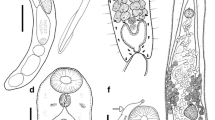Summary
The morphology of Trichobilharzia parocellata from the portal and mesenteric blood vessels of Anas gibberifrons and A. superciliosa from northern Australia is described. The life-cycle was completed in domestic Muscovy ducks exposed to Cercaria parocellata from naturally infected Lymnaea lessoni. Adults of T. parocellata are distinguished from closely related species by the point of caecal reunion in the male, the number of testes, the nature of the tegument and the species of snail hosts. The miracidia differed from all others in the genus except T. indica in having a pair of coarsely granular posterior secretory glands, a pair of apical glands, a papilla on each side in front of the lateral processes and 18 to 20 germinal cells in a single germinal mass. The prepatent period of T. parocellata in Muscovy ducks was only 11 days after exposure. Pigeons did not become infected. ac]19840624
Similar content being viewed by others
References
Balenger, J. & Neuzil, E. (1953) Nouvelles techniques d'examen des helminthes: fixation, colouration, montage. Annales de Parasitologie humaine et comparée, 28, 392–398.
Bearup, A.J. (1956) Life cycle of Austrobilharzia terrigalensis Johnston, 1917. Parasitology, 46, 470–479.
Bearup, A.J. (1965) Cercarial dermatitis in Tropical Australia. Australian Journal of Science, 28 (4), 165–166.
Bearup, A.J. & Langsford, W.A. (1966) Schistosome dermatitis in association with rice growing in the Northern Territory of Australia. Medical Journal of Australia, 1 (13), 521–525.
Blair, D. & Copeman, D.B. (1977) Schistosome dermatitis in North Queensland. Medical Journal of Australia, 1(8), 40.
Blair, D. & Islam, K.S. (1983) The life cycle and morphology of Trichobilharzia australis n.sp. (Digenea: Schistosomatidae) from the nasal blood vessels of the black duck (Anas superciliosa) in Australia with a review of the genus Trichobilharzia. Systematic Parasitology, 5, 89–117.
Clark, S.A. & Stone, A.R. (1975) A simple method of preparing nematodes for scanning electron microscopy using Spurr's low epoxy resin. Nematologica, 21, 256–266.
Islam, K.S. (1982) Studies on three new species of Australian avian schistosomes. Ph.D. Thesis. James Cook University of North Queensland, Australia, 294 pp.
Islam, K.S. (in press) The morphology and life cycle of Trichobilharzia arcuata n.sp. (Schistosomatidae: Bilharziellinae), a nasal schistosome of water whistle ducks (Dendrocygna arcuata) in Australia. Systematic Parasitology.
Islam, K.S. & Copeman, D.B. (1980) Notes on the life cycle of Trichobilharzia farocellata (sic) Johnston and Simpson, 1939. Abstracts of Papers presented at the 24th conference of the Australian Society of Parasitologists, p. 49.
James, C. & Webbe, G. (1973) A comparison of Egyptian and East African strains of Schistosoma haematobium. Journal of Helminthology, 47, 49–59.
Johnston, T.H. (1941) Bather's itch (Schistosome dermatitis) in the Murray Swamps, South Australia. Transactions of the Royal Society of South Australia, 65(2), 276–284.
Johnston, T.H. & Simpson, E.R. (1939) Larval trematodes from Australian terrestrial and fresh water molluscs. Part V. Transactions of the Royal Society of South Australia, 63(1), 63–68.
McFarlane, W.V. (1952) Schistosome dermatitis in Australia. Medical Journal of Australia, 1, 669–672.
McLeod, J.A. (1940) Studies on cercarial dermatitis and trematode family Schistosomatidae in Manitoba. Canadian Journal of Research, 18, Sect. D, No. 1, 1–28.
Neuhaus, W. (1952) Biologie und Entwicklung von Trichobilharzia szidati n.sp. (Trematoda: Schistosomatidae) einem Erreger von Dermatitis beim Menschen. Zeitschrift fur Parasitenkunde, 15, 203–266.
Rowntree, S. & James, C. (1977) Single sex cercariae of Schistosoma mansoni, a comparison of male and female infectivity. Journal of Helminthology, 51, 69–70.
Szidat, L. (1942) Was its Cercaria ocellata La Valette? Morphologische und entwicklungsgeschichtliche untersuchungen über den Erreger der europäischen Cercarien Dermatitis Menschen. Deutsche Tropenmedizinsche Zeitschrifte, 46, 481–497, 504–524.
Wright, C.A. & Bennet, M.S. (1967) Studies on Schistosoma haematobium in the laboratory. I. A strain from Durban, Natal, South Africa. Transactions of the Royal Society of Tropical Medicine and Hygiene, 61, 221–227.
Yamaguti, S. (1971) Synopsis of digenetic trematodes of vertebrates. Keigaku Publishing Co., Tokyo, 1074 pp.
Author information
Authors and Affiliations
Rights and permissions
About this article
Cite this article
Islam, K.S., Copeman, D.B. The morphology and life-cycle of Trichobilharzia parocellata (Johnston & Simpson, 1939) Islam & Copeman, 1980 from the visceral blood vessels of Australian anatids. Syst Parasitol 8, 39–49 (1986). https://doi.org/10.1007/BF00010308
Accepted:
Issue Date:
DOI: https://doi.org/10.1007/BF00010308



